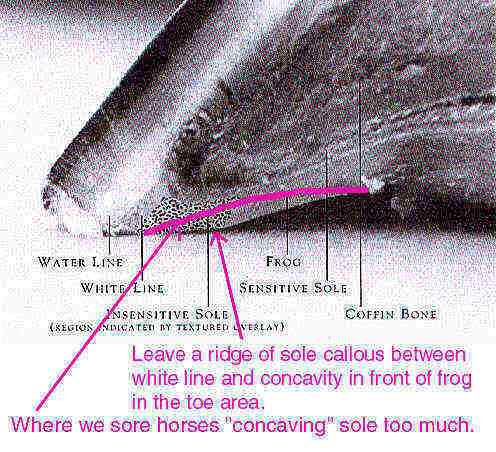
Photo of Wild Horse Foot Cross-Section,
From Jaime Jackson's "The Natural Horse"
Treating Founder (Chronic Laminitis) without Horseshoes, Section 13
(Version with full-sized photos)
Don't Pare Out too Much Sole in the toe area!!!--a common mistake
So many people pare out sole at the toe to "concave out" the sole all the way back to the white line. This is not how wild horses wear their hooves. You leave the coffin bone too unprotected, and your horse will be sore. It takes a long time to form callous, and it is there for a reason! It also helps support and protect the coffin bone. There should be a ridge of sole callous behind the white line.
While I greatly applaud Bergy's efforts to popularize the idea of lowering heels and backing up toes, concaving soles all the way forward is one area where I disagree with him. I was relieved to see that Dr. Strasser recommends leaving a crescent-shaped ridge of sole callous at the toe, which she calls the "moonsickle," as I had discovered through trial and error that leaving this sole callous gave more support to the coffin bone, tightened my horse's white lines up, and allowed him to not be sore the first day or so of a new trim, as he was when I "concaved out" his soles all the way forward to the white line at the toes. This concaving out all the way forward to the white line in the toe area was something I saw a lot of at the Bergy clinic. In horses with any rotation, it results in bleeding and soreness.

Photo of Wild Horse Foot Cross-Section,
From Jaime Jackson's "The Natural Horse"
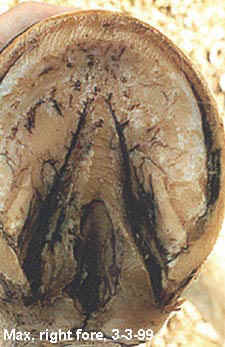
Recent photo of Max showing how I am now leaving a crescent-
shaped ridge of sole callous behind the white line at the toe.
I still concave out to the white line on the sides, but not at the toe.
Note: heels and bars too high; heels contracted; need opening cuts.
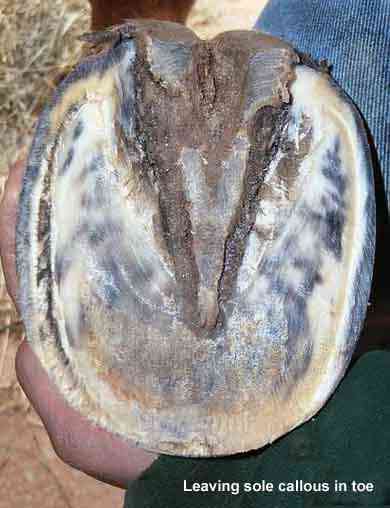
Trimming a foundered foot, leaving sole callous in toe area.
(Courtesy of Cindy Sullivan)
Sabine Kells tells me he still had his heels and bars too high here, and that his heels were still contracted. She warned me that with these problems, he would be likely to founder again. Sure enough, in the spring, he came up sore on the new grass! I turned things around quickly by dry-lotting him right away and giving a dose of UAA Gel. Since I have learned more about the Strasser trim, though, he is grazing again successfully. It seems like a real milestone that he is free again!
In retrospect, though, in the period of time when I was working him so much and so often barefoot that he never needed a trim, he did not founder on some large pastures. His constantly maintained barefoot hoof shape and activity level gave him enough hoof mechanism and circulation to withstand laminitis triggers much better.
What my experiences with treating Max’s founder without shoes have shown is:
As long as you keep leverage off the toe, like a constantly worn wild horse-shaped hoof would, and in the shape of that wild horse hoof, the laminae will grow back in tighter.
Things must be changing internally as well—I am starting to see more concavity in Max’s feet, which is a real improvement over the dropped sole before! The entire shape of the hoof capsule is changing for the better.
The improved circulation from being barefoot and having more naturally-shaped hooves has resulted in thicker, more "alive"-textured hoof walls and soles, even though the ground had been non-stop mud for months. The white line is the most solid it has been in 10 years. It used to be really pitted and full of dark slits.
I have now seen that even a truly distorted foot like Max’s can recover with frequent mustang trims. He is still far from being fully rehabilitated, but he has certainly been moving in the right direction.
To show this, I am including photos of Max’s old ‘93-4 heartbars being held up to his feet, showing that the base of support is moving rearwards quite dramatically.
Moving Max's Base of Support Rearwards
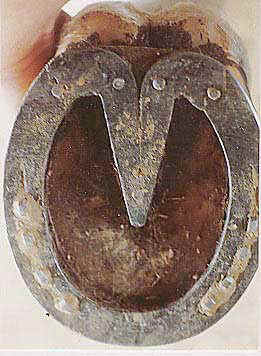
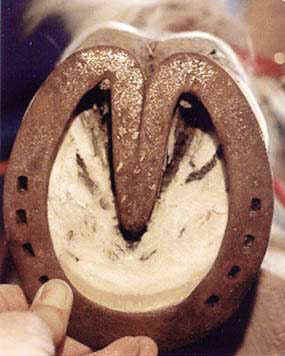
Left--Left fore, '93 resection at OSU. Note heels hanging out over the back of shoe, and long distance from apex of frog to point of breakover.
Right--December 21, l997--The shape of the hoof has compressed from front to back so much that the heels are no longer hanging so far out over the back, and the white line is actually inside the shoe. This represents a backing up of the point of breakover of at least 3/4 of an inch.
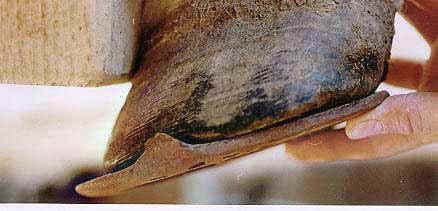
Left fore, October 30, 1997. Note the base of support is already moving backwards. Old '93-4 heartbar shoe, when lined up with the apex of the frog, shows how the shape of the foot has compressed from front to back. Heels still way too high here!
Below--What NOT to do!!! This dressage mare is headed for trouble with her very long, contracted, under-run heels, and toes stretched forward. This is moving the base of support forwards--exactly the opposite of what you should be doing. Lowering her heels and backing up her toes will bring the base of support backwards, under the bony column where it belongs. Heels of shoes are way too far forward.
That this mare is not foundered illustrates that even a "normal" foot can have the toe stretched forward with long-term improper shoeing and long toes. This mare's hoof shape, which impairs circulation, makes her much more susceptible to laminitis, though.
Further, expecting a horse to be able to do dressage with her feet done in this style is totally unreasonable. Refer to the farriery chapter in Mary Wanless' book, "For the Good of the Horse," for a detailed explanation of why having improper angles and the base of support sliding so far out in front of the bony leg column makes it so much harder for this mare to collect herself and carry herself well. This kind of farriery is more conducive to back pain and a hollow-backed, ewe-necked carriage....along with corns, filled legs, bowed tendons and "navicular syndrome."
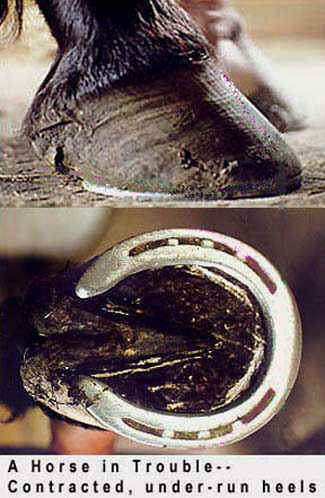
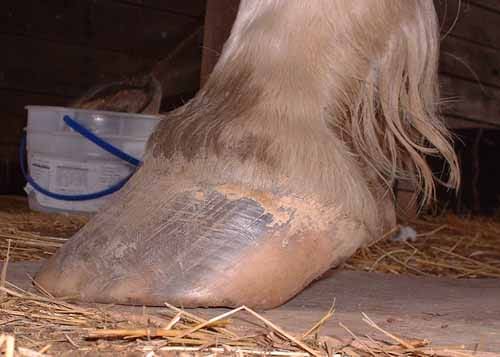
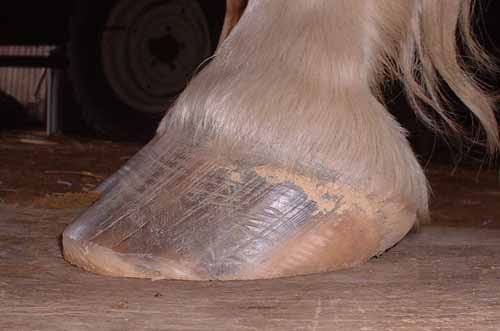
An under-run heel being shortened enough to move the weightbearing
surface of the hoof further back. Breakover also backed up some.
What I now believe is that laminitis in our domestic horses usually involves reduced circulation from poor hoof mechanism--high, contracted heels and long toes. There is often more emphasis on using drugs alone to cover up acute episodes, when a mustang-shaped trim to reduce leverage on the toe, and restore hoof mechanism and circulation, plus more activity, is the most important part of any treatment. I believe much road founder could be prevented by constantly maintaining a wild horse-shaped hoof, which greatly reduces leverage on the laminae. A horse who has systemic laminitis, such as grass founder, will probably come through it with minimal damage if the systemic cause is removed (i.e., dry-lot him in the case of grass founder), and a wild-horse-shaped trim is done. Restoring hoof mechanism, trimming to get the bottom of the coffin bone ground-parallel, and keeping the horse more active with free living conditions 24 hours a day all help prevent future incidents.
If wild horses do founder, they can come out of it better because the shapes of their hooves put less leverage on the laminae than our shod and/or over-grown horses have. Their frogs being close to the ground gives more support to the coffin bone to prevent rotation. The other reason they can do better is the constant exercise they get walking around grazing 12-14 hours a day. All this activity enhances circulation. I believe stalled horses are at a disadvantage because constant movement is vital to circulation.
Jaime Jackson and other wild horse researchers were hard-pressed to find freshly captured wild horses who were foundered, leading them to conclude that founder is a man-made malady. Dr. Stasser explains this phenomenon in terms of wild horses' hoof shapes and constant movement providing enough circulation to effectively prevent laminitis.
There was one notable exception, though--Jaime Jackson saw an entire wild herd foundered when they had been fenced into a "riparian" area in wild horse country--an oasis-like area of knee-deep lush, green grass and plentiful water. The wild horses he had seen elsewhere in wild horse country, when free, only watered in these areas, but did not choose to remain there. They tended to roam and graze in arid, rocky, high desert environments that he feels their species evolved in and is best suited to. The vegetation in these areas is "barren and sprinkled lightly with bunch grasses, sparse forage, and an abundance of rocks." (from "Founder, Prevention and Cure the Natural Way" by Jaime Jackson, published in March, 2001.) They had to travel many miles a day on such terrain to get enough to eat, which kept their hooves naturally in trim. Jackson believes that lush, green pasture is not what horses are evolved to do well on, and he advocates dry-lotting horses if your terrain provides rich, lush, green grass.
Back to home page--Table of Contents
Article in sections with "thumbnail" photos for fastest downloads:
1 9 17
2 10 18
3 11 19
4 12 20
5 13 21
6 14 22
7 15 23
8 16 24
NAVICULAR
Article in sections with full-sized photos for print-outs:
1 9 17
2 10 18
3 11 19
4 12 20
5 13 21
6 14 22
7 15 23
8 16 24
NAVICULAR
To Strasser case studies--thumbnail photos for faster downloads
To Strasser case studies--large photos
Please sign my guest book! Photos of my pets My farm
Share Barefoot success stories on this page
Buy or sell used HORSE BOOTS Natural board Barn Listings
Click here to subscribe to naturalhorsetrim
(I moderate this listserv to weed out "fluff.")
Send Email to Gretchen Fathauer, or call (740) 674-4492
Copyright by Gretchen Fathauer, 2015. All rights reserved.